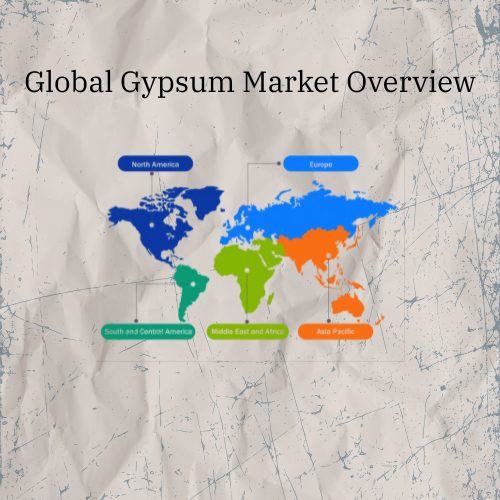Global Gypsum Market Outlook 2025–2030: Emerging Trends, Demand Drivers, and Future Opportunities
The global gypsum market will grow significantly from 2025 to 2030. This growth is fueled by strong construction demand, wider use of gypsum board, expansion of synthetic gypsum, and a rising focus on recycling and sustainability.
Market Size, Volume & Growth Outlook
According to Mordor Intelligence, global gypsum production will grow from 338.15 million tons in 2025 to 441.95 million tons by 2030. This represents a CAGR of 5.5%.
Future Market Insights expects market revenue to rise from USD 36.2 billion in 2025 to USD 68.5 billion by 2035, with a CAGR of 6.3%. Plasterboard will account for around 45% of total demand in 2025.
Grand View Research forecasts the gypsum plaster segment to grow from USD 3.41 billion in 2024 to USD 4.92 billion by 2030, with a CAGR of 6.3% during 2025–2030.
The gypsum board market, valued at USD 55.91 billion in 2023, will likely reach USD 127.06 billion by 2030. This reflects a CAGR of 12.7%, according to Grand View Research.
Other forecasts include:
- TechSci Research: USD 47.24 billion in 2024 → USD 68.19 billion by 2030 (CAGR ~6.15%)
- Next Move Strategy: USD 81.06 billion by 2030 (CAGR ~10.2%)
Overall, growth rates vary by segment, ranging from 5% to 12% depending on application and region.
Types of Gypsum and Product Applications
Natural Gypsum (Calcium Sulfate Dihydrate)
Used in gypsum plaster, wallboard, cement additives, soil amendments, and plaster of Paris.
Synthetic Gypsum
Mainly produced via flue gas desulfurization (FGD). It is chemically identical to natural gypsum and is used in drywall, plaster, cement additives, and agriculture.
- Revenue in 2024: USD 2.06 billion → USD 2.59 billion by 2030 (~4.1% CAGR)
- Another estimate (360iResearch): USD 1.33 billion in 2025 → USD 1.77 billion in 2030 (~4.9% CAGR)
Gypsum Board / Drywall / Plasterboard
This segment includes wallboard, ceiling board, Type X fire-resistant boards, moisture-resistant types, and soundproof panels.
- Market forecast: USD 127 billion by 2030 (12.7% CAGR)
- Asia-Pacific held 46.6% of global volume in 2023
- Wallboard accounted for about 50.3% of product share
Applications span residential, commercial, industrial, institutional, and modular buildings.
Gypsum Plaster
Used mainly for interior walls and mortar systems. Valued at USD 3.41 billion in 2024, it is set to reach USD 4.92 billion by 2030, with a 6.3% CAGR.
Regional Contributions & Growth Hotspots
Asia-Pacific leads global gypsum consumption in both volume and value. Rapid urbanization in countries like China, India, and Indonesia drives demand. The region also dominates gypsum board and synthetic gypsum markets.
North America and Europe remain key markets. North America leads in synthetic gypsum with 28% market share (2024).
According to Grand View Research:
- Asia-Pacific shows the fastest gypsum board growth
- Europe and North America maintain steady but slower growth
Next Move Strategy reports that global construction value will reach USD 16.1 trillion by 2030. Gypsum board will play a critical role in this expansion.

Key Growth Drivers & Challenges
Drivers
- Expansion of residential and commercial construction
- Growing demand for fire-resistant, soundproof, and lightweight materials
- Strong shift toward synthetic gypsum and recycled materials
- Government infrastructure projects and affordable housing initiatives
Challenges
- Competition from materials like fiber cement and lime plaster
- Regulations limiting gypsum extraction and disposal
- Environmental issues from landfilling gypsum waste (hydrogen sulfide, methane emissions)

Circular Economy & Gypsum Recycling
Recycled gypsum comes mostly from construction and demolition waste, especially plasterboard. This material can re-enter production through closed-loop recycling.
Gypsum Recycling International (GRI) launched recycling in Denmark and achieved recovery rates up to 80%. Its system now operates in several European countries, the U.S., and Japan.
Closed-loop recycling reduces the need for raw gypsum and cuts energy use. It supports targets like the EU’s 70% reuse mandate for construction waste.
Market Segmentation Summary
| Segment | Value (USD Billion) | CAGR (2025–2030) | Key Features |
|---|---|---|---|
| Gypsum (overall) | ~36.2 (2025) → 68.5 (2035) | ~6.3% | Includes natural & synthetic types, driven by plasterboard |
| Gypsum Board | 55.9 (2023) → 127.1 | ~12.7% | Wallboard ~50%, APAC leads |
| Gypsum Plaster | 3.41 (2024) → 4.92 | ~6.3% | Mainly manual plaster |
| Synthetic Gypsum | 2.06 (2024) → 2.59 | ~4.1% | FGD gypsum, North America leads |
Strategic Outlook & Key Players
Major companies:
Saint-Gobain, Knauf Gips, USG Corporation, Etex Group, National Gypsum, LafargeHolcim
Strategic focus areas:
- Expanding in Asia-Pacific to meet growing construction demand
- Developing fire, moisture, and sound-resistant gypsum board
- Investing in recycling systems and synthetic gypsum tech
- Building partnerships to innovate and expand globally
The gypsum market will expand steadily through 2030. Growth is driven by construction demand, increased use of drywall and plaster, and environmental policies favoring recycling and synthetic gypsum.
Gypsum board is the most dynamic and valuable segment, with projected revenues reaching USD 127 billion.
Synthetic gypsum, while smaller, shows steady 4–5% CAGR due to sustainability trends.
Plaster continues to be essential for interior work, with moderate but reliable growth.
Asia-Pacific dominates in both demand and supply, while North America and Europe focus on innovation and circular practices.
For market players, success depends on sustainable sourcing, smart recycling systems, specialized product development, and regional growth strategies.
FAQ
1 : market from 2025 to 2030?
Answer:
Key growth drivers include the expansion of construction and infrastructure projects, rising demand for gypsum board and plaster, adoption of synthetic gypsum, and an industry-wide shift toward recycling and sustainable building materials.
2 : Which segment of the gypsum market is expected to grow the fastest?
Answer:
The gypsum board segment (drywall/plasterboard) is projected to grow the fastest, with a CAGR of approximately 12.7%, reaching an estimated USD 127 billion by 2030.
3 : Why is synthetic gypsum gaining popularity in the market?
Answer:
Synthetic gypsum is increasingly used due to its environmental benefits, regulatory support, and chemical similarity to natural gypsum. It helps reduce waste from coal plants and supports circular economy initiatives in construction.




